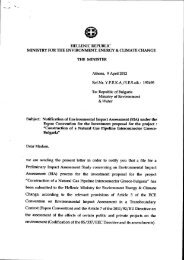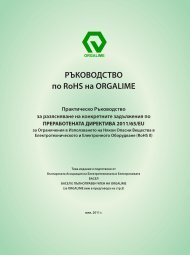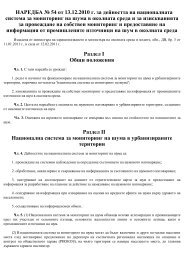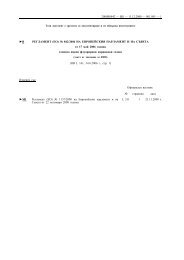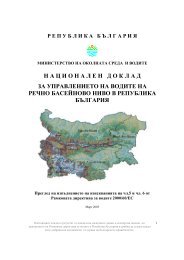Програма на научната конференция - Министерство на ...
Програма на научната конференция - Министерство на ...
Програма на научната конференция - Министерство на ...
- No tags were found...
Create successful ePaper yourself
Turn your PDF publications into a flip-book with our unique Google optimized e-Paper software.
The average number of pups was 6.9±1.6. During the second period (1907-1924),the number of wolves increased to 925 killed individuals. Average number of cubswas 6.7±1.1. In the end of the third period (1925-1933), only 219 individuals werekilled (average pups were 6.5±1.1). During the fourth period (1934-1954), thenumbers of wolves increased and 1079 individuals were killed in 1954 but averagepups were 6.1±0.8. In fifth period (1955-1975), numbers of wolves decline and 75wolves were killed in 1975, with average of pups 6.2±0.9. During the sixth period(1976-1989), wolf population increased and 225 individuals were killed in 1989but the average number of pups was 5.1±1.1. There is no connection between andthe numbers of wolves in different periods and the average numbers of pups (p >0.05). The reason for the increase of wolves in the period 1975–1990 was theincrease of the number of ungulates, the legislational restriction of the use ofpoison and taking the litters from people. After 1990, the reduction of the foodrecourses leads to the decrease of the wolf population. Most significant populationof wolves is around southern borders where its control is difficult due to theopportunities of wolves to pass to the territory of Greece in cases of danger.10:15-11:00Сесия “Климатични промени и биоразнообразие”Съпредседатели: Н. Чипев и З. БоевSession “Climate change and biodiversity”Co-chairmen: N. Chipev and Z. Boev10:15-10:30ГЕОИСТОРИЧЕН АНАЛИЗ НА РАСТИТЕЛНОТО РАЗНООБРАЗИЕ –ПРОБЛЕМИ И ПЕРСПЕКТИВИД. ИвановИнститут по ботаника, БАН, ул. Акад. Георги Бончев, бл. 23, 1113 София;E-mail:dimiter@bio.bas.bgДнес сме изправени пред драстично <strong>на</strong>маляване <strong>на</strong> биоразнообразието <strong>на</strong>сухоземните екосистеми, тъй като хабитатите са силно повлияни ипроменени от човешката дейност. Геоложката история <strong>на</strong> земнитеекосистеми предоставя важ<strong>на</strong> информация относно основни проблеми в<strong>на</strong>рушаването <strong>на</strong> окол<strong>на</strong>та среда и въздействието им върху биологичноторазнообразие. Палеонтологията ни дава ед<strong>на</strong> добра възможност да проследимкак биоразнообразието се е променяло през отми<strong>на</strong>лите епохи, с оглед даразберем по-добре съвременния му статус. В седиментните скали са запазенидостатъчно свидетелства за биологичното разнообразие в ми<strong>на</strong>лото по <strong>на</strong>чин,който е уникален за отделните екосистеми. Пълноценното изследване <strong>на</strong>проблемите <strong>на</strong> фосилното разнообразие, както и използването <strong>на</strong> различнитедоказателства запазени в седиментните скални пластове, са все ощенедостатъчно разработени. Фосилните растителни комплекси могат многодобре да отразяват многообразието <strong>на</strong> съобщества и природни обстановки, но51







